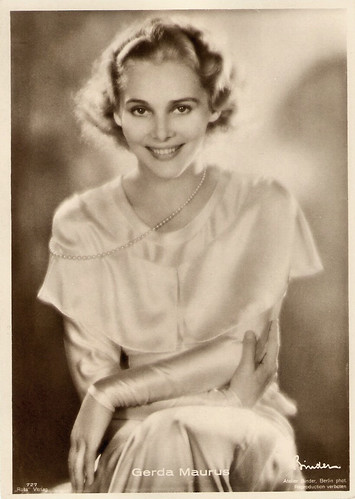
German postcard by Ross Verlag, no. 727, 1925-1926. Photo: Atelier Binder, Berlin.
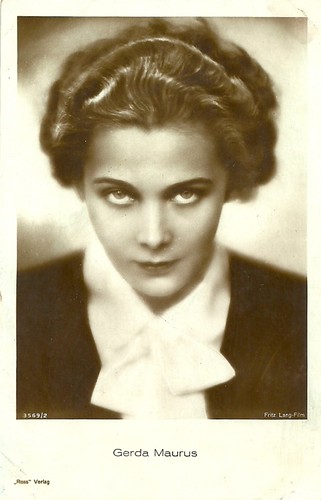
German postcard by Ross Verlag, no. 3569/2, 1928-1929. Photo: Fritz Lang Film.
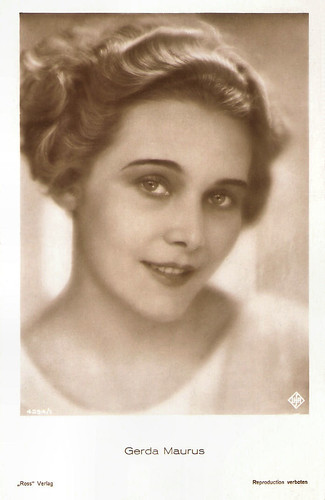
German postcard by Ross Verlag, no. 4254/1, 1929-1930. Photo: Ufa.
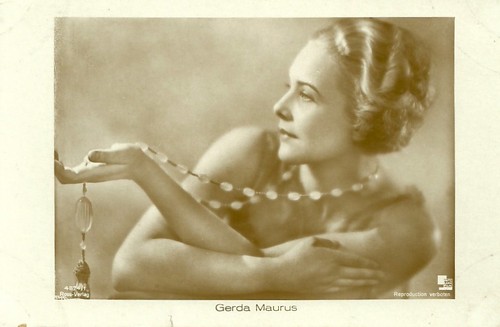
German postcard by Ross Verlag, no. 4874/1, 1929-1930. Photo: Fritz Lang Film.
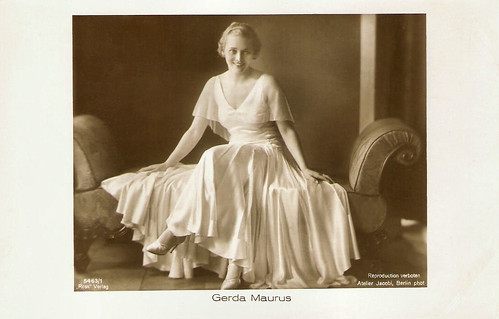
German postcard by Ross Verlag, no. 5463/1, 1930-1931. Photo: Atelier Jacobi, Berlin.
Fritz Lang
Gerda Maurus was born as Gertrud Maria Pfiel in Breitenfurt, Austria, in 1903. She grew up in Wien (Vienna).
In 1918, the only 15 years old Gerda had her first engagement at one of the theatres of Vienna. As a stage actress she worked at the Volkstheater in München (Munich), in Nürnberg (Neurenberg) and from 1926 on at the Deutschen Theater in Berlin.
There she was discovered by director Fritz Lang, who choose her for the female leading role of a Russian spy in his next thriller, Spione/Spies (1928).
Spione was Lang’s first independent production. The years-ahead-of-its-time plotline involves Russian espionage activity in London. The mastermind is Haghi (Rudolph Klein-Rogge), a supposedly respectable carnival sideshow entertainer. Heading the good guys is Agent 326 (Willy Fritsch), with the help of defecting Russian spy Sonya, played by Gerda Maurus.
The film moves swiftly to several potential climaxes, each one more exciting than its predecessor. According to Hal Erickson of AllMovie, “Haghi's ultimate demise is a superbly staged Pirandellian vignette. Anticipating Citizen Kane by a dozen years, director Lang dispenses with all transitional dissolves and fade-outs, flat-cutting territory from one scene to another”.
Gerda fascinated him thus that Lang finished his relationship with his partner and wife, Thea von Harbou, who had co-scripted Spione with him.

German postcard by Ross Verlag, no. 8667/1, 1933-1934. Photo: Cserepy-Normation-Film / NDLS.

Austrian postcard by Iris-Verlag, no. 5718. Photo: Förster / E. Schneider.
German postcard by Ross Verlag, no. 8061/1, 1933-1934. Photo: Atelier Binder, Berlin.
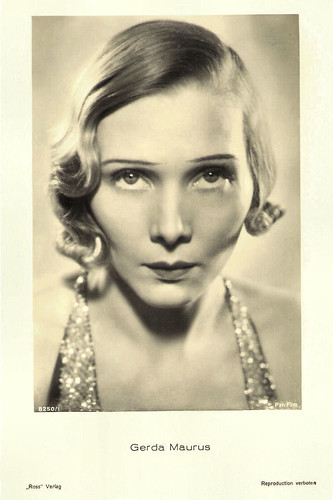
German postcard by Ross Verlag, no. 8250/1, 1933-1934. Photo: Pan Film.
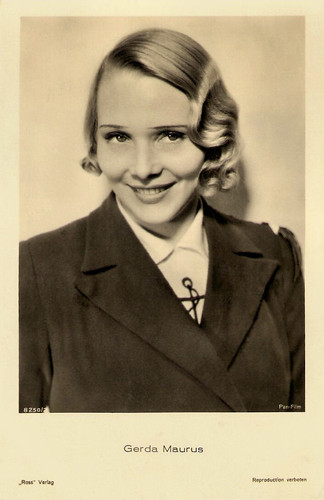
German postcard by Ross Verlag, no. 8250/2, 1933-1934. Photo: Pan Film.
Countdown Before Blast-off
For Gerda Maurus her film debut was also her breakthrough. Her next film was the science-fiction film Frau im Mond/Woman in the Moon (1929), again with Willy Fritsch and again directed by Fritz Lang.
Frau im Mond is one of the first major films to dwell upon the possibility of space travel. Hal Erickson writes that it is, “like many of its modern-day counterparts, more successful on a special-effects level than it is in terms of character development”.
Among the many prescient aspects of the film is its use of a countdown before blast-off and its depiction of the effects of centrifugal force upon the lunar passengers. Willy Ley, later a leading light of the U.S. space program, served as technical adviser. Reportedly, Adolf Hitler was so overwhelmed by Frau im Mond that he used the rocket depicted in the film as the prototype for the dreaded V1 and V2 assault missiles.
In Frau im Mond Maurus joined the extra-terrestrial expedition in search of gold on the moon. And again she was a huge success.
The arrival of sound did certainly not finish Maurus’ film career. She starred as a film diva in the intricate murder mystery Der Schuß im Tonfilmatelier/The Shot in The Talker Studio (Alfred Zeisler, 1930) set in the Ufa film studio in Babelsberg.
In Der Weisse Dämon/White Demon (Kurt Gerron, 1932) she featured as a drug-addicted opera star, opposite Hans Albers and Peter Lorre .
During the Nazi period, the actress had a close contact with Propaganda Minister Joseph Goebbels. After Fritz Lang had emigrated in 1933, she reportedly often visited his salon. Her charms did not only turn Goebbels on but also the communist dramatist Friedrich Wolf.
In 1937 she married Robert A. Stemmle, who directed her in the film Daphne und der Diplomat/Daphne and the Diplomat (1937). They would have a daughter, Philine, born in 1943.
Maurus appeared in more popular films like Der Dschungel ruft/The Call of the Jungle (Harry Piel, 1936), Grenzfeuer/Boundary Fire (Alois Johannes Lippl, 1939) and Die gute Sieben/The Lucky Seven (Wolfgang Liebeneiner, 1940), but none of these films came near to the great successes of her first films with Fritz Lang.
She concentrated on stage work and performed in Berlin, Wien, München and Düsseldorf. After 1945 Maurus played in only two more German pictures: the comedies Die Freunde meiner Frau/My Wife’s Friends (Hans Deppe, 1949) and Die kleine Stadt will schlafen gehen/The Little Town Wants To Sleep (Hans H. König, 1953).
Later she appeared in the TV-plays Wir sind noch einmal davongekommen/The Skin of our Teeth (Karl-Heinz Stroux, 1951) and one year later in Vor Sonnenuntergang/Before Sunrise (Karl-Heinz Stroux, 1962). Her last TV appearance was in a supporting part in Das Käthchen von Heilbronn/Cathy of Heibronn (1968), an adaptation of the classic play by Heinrich von Kleist.
Gerda Maurus died in 1968 in Düsseldorf, Germany.
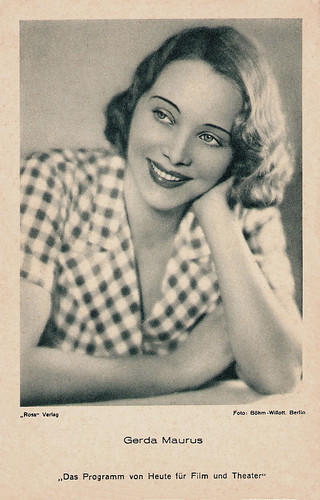
German postcard by Das Programm von Heute für Film und Theater / Ross Verlag, Berlin. Photo: Böhm-Willott, Berlin. Collection: Miss Mertens.
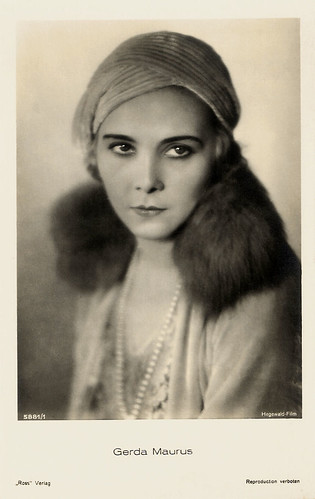
German postcard by Ross Verlag, no. 5881/1, 1930-1931. Photo: Hegewald Film.
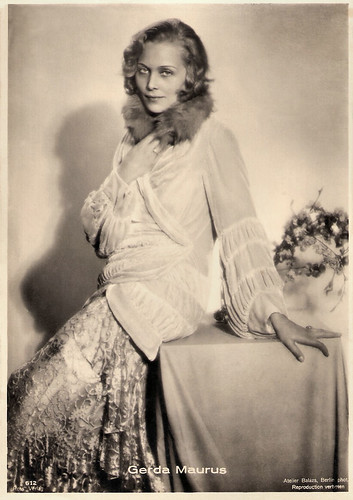
German postcard by Ross Verlag, no. 612. Photo: Atelier Balázs, Berlin.
The great Rudolf Klein-Rogge in the climax scene of Spione (1928). Source: Manferot (YouTube).
Launch of the rocket scene from Frau im Mond (1929). Source: Manferot (YouTube).
Landing of the rocket scene from Frau im Mond (1929). Source: Manferot (YouTube).
Sources: Thomas Staedeli (Cyranos), Hal Erickson (AllMovie), Stephanie D'heil (Steffi-line - German), Wikipedia (German), and IMDb.
3 comments:
What an interesting post and great film clips.
Too bad Maurus did not meet Lang earlier...she could have been in Metropolis too
Thanks. This summer I happened to see a restored print of Metropolis with my eldest son in the wonderful Castro movie palace in San Francisco. My 17-year-old son, who likes Tarantino and doesn't care much for black and white movies, simply adored Metropolis. And Brigitte Helm is excellent in this film. It was good that Gerda Maurus had to wait one film to join Lang.
Post a Comment